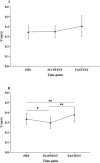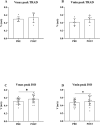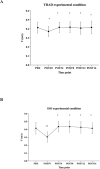Intermittent Voluntary Isometric Contractions Effects on Performance Enhancement and Sticking Region Kinematics in the Bench Press
- PMID: 37229417
- PMCID: PMC10203844
- DOI: 10.5114/jhk/161777
Intermittent Voluntary Isometric Contractions Effects on Performance Enhancement and Sticking Region Kinematics in the Bench Press
Abstract
During the last years, post-activation performance enhancement (PAPE) has gained notorious popularity due to the capacity to improve the acute rate of force development (RFD) using different strategies with different muscle contraction regimes as conditioning stimuli. The aim of the present study was to analyse the role of a maximal isometric post-activation performance enhancement (PAPE) protocol in performance and its effects on the kinematics of the sticking region. Twenty-one trained participants (age 26.4 ± 5.4 years) underwent two experimental sessions: an experimental session consisting of a single set and a single repetition of the bench press at the 93% of 1RM (which is considered a traditional conditioning activity to induce PAPE) (TRAD) and an isometric experimental session (ISO) consisting of 15 maximal voluntary isometric contractions in the sticking region of the medium grip bench press lasting 1 s with a 1 s rest interval between contractions. Both TRAD and ISO experimental conditions improved performance from post0 to post4, post8, post12 and post16, but only the ISO condition improved performance from the start of the lift to the start of the sticking region from pre to post (p < 0.001), and only the ISO condition improved maximum (p = 0.005) and minimum (p = 0.025) peak velocities. The results of this study suggest that short duration maximal voluntary isometric contractions improve the velocity of the lift prior to the initiation of the sticking region, which ultimately improves the impulse and facilitates the lift.
Keywords: athletic performance; strength training; training; warm up.
Copyright: © Academy of Physical Education in Katowice.
Figures





References
-
- Chiu, L. Z. F., & Barnes, J. L. (2003). The Fitness-Fatigue Model Revisited: Implications for Planning Short-and Long-Term Training. Strength and Conditioning Journal, 25, 42–51. 10.1519/00126548-200312000-00007 - DOI
-
- Cohen, J. (1988). Statistical power analysis for the behavioral sciences (2nd ed.). L. Erlbaum Associates. https://www.worldcat.org/title/statistical-power-analysis-for-the-behavi...
LinkOut - more resources
Full Text Sources
